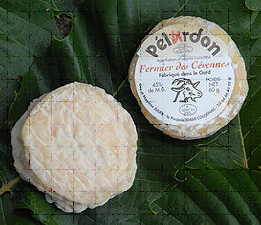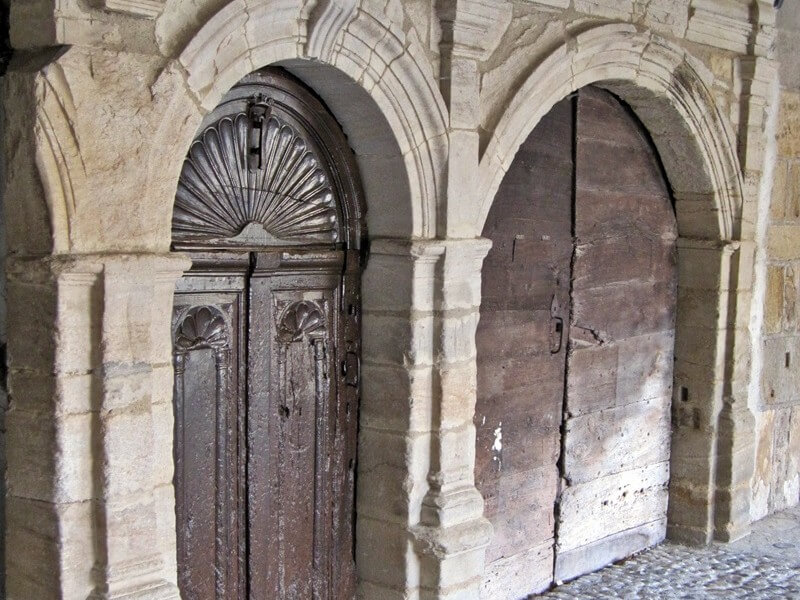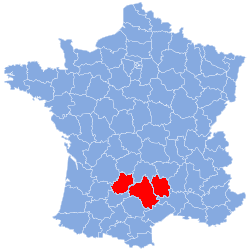Causses Sud
Pays Cathare & Gorges du Tarn, Roquefort
The stronghold of first, the Saracens, then the Cathars and finally the Huguenots, this land bears witness to an intense and dramatic history of religious devotion, the English and the French, famous cheeses, foie gras and robust wine.
Explore incredibly beautiful region with its medieval history and discover the quintessential cheeses of this high plateau region – Roquefort, Rocamadour, Bleu des Causses, Cabécou and Pelardon and its foie gras, truffles, walnuts, chataigne and the wonderful wines of Cahors, Bergerac and Gaillac and Armagnac are all to be discovered in a fabulously beautiful yet little known region.

The Cheeses
Roquefort
Bleu des Causses
Pelardon
Pérail/ Pérail des Cabasses
Roquefort
The ‘King of Cheeses’ Diderot called it, Roquefort is considered to be the world’s most famous cheese. Pliny the Elder mentioned it in his dissertations around 79 AD which appears to be the first record of the cheese. It has a long history from being purported to be the favourite of Charlemagne to the royal grant of King Charles VI in 1411 to the village of Roquefort-sur-Soulzon as the official producers of the cheese, the cheese has made its mark on the world.
According to historical data, the cheese received the first AOC (Appellation d’Origine Contrôlée) in France in 1925, This distinction was created to define and control the production and ultimately the naming of cheeses in the country. According to the official Roquefort brand website, in 1930, the Confédération Générale de Producteur de lait de Brebis et des Industriels de Roquefort, otherwise known as the General Confederation of Ewe’s Milk Producers and Industrialists of the Land of Roquefort, governed by production regulations created a collective brand known as “Red Ewe”. The cheese is packaged with a foil seal displaying the red sheep symbol, which is a registered trademark in more than 70 countries and signifies the product as an authentic French Roquefort. Then following a landmark ruling in 1961 by the Tribunal de Grande Instance at Millau, imitation of the cheese could continue via manufacturing techniques throughout southern of France, only those cheeses where aging occurred in the natural limestone caves of Mont Combalou in Roquefort-sur-Soulzon were permitted use the name Roquefort. By 2003 there were only seven independent producers still remaining.
The largest producer being Roquefort Société (originally known as Société des caves et des producteurs réunis de Roquefort or The Assembly of Roquefort Caves and Producers Society) regrouped many of the smaller regional producers. To date as the largest producer, they represent 66% of the overall French market and produce three main brands: Templiers, which we find the strongest of the three, Baragnaudes, is more subtle in flavour and, their 1863, which is purportedly an homage to a classic Roquefort, but for us is much less pronounced flavour. All of these products are aged in the extensive labyrinth of limestone caves.
The second largest producer is Roquefort Papillon with 10% of the market. There are five others groups producing the cheese today, from the highly sought after but small producer Combes Le Vieux Berger to Carles and Gabriel Coullet who produce outstanding cheeses, to les Fromageries occitannes and Vernières.
Made from almost exclusively from the milk of the Red Lacunae sheep who graze on the Rouergue Causses plateaux in Aveyron centred near the city of Millau. This cheese is generally creamy and white and has a buttery texture with blue mould veins extending from its centre to the edges of the wheel created by the injection of “Penicillium roqueforti” at either the heating stage of the milk or the curd stage.
The initial aging is approximately three weeks, depending on the producer. As per the decree, ripening of the cheeses must be done in the natural caves found under the village of Roquefort-sur-Soulzon. These limestone caves were created by geologically movement of ‘les causses’ plateaux which created aerated pockets riddled with crevasses called ‘fleurines’. The natural ventilation circulates air while the extreme damp helps slowly produce a pâte which is buttery and dense and at the same time a bit crumbly with a shiny white and mottled exterior. To stop the blueing process and further aid in the rounding out of flavours, the ‘loaves’ are then encased in a thin aluminium foil and left to further age in these caves for up to three to ten months.
It is said that a good Roquefort cheese should never be aggressive, but must recall the specific taste of sheep’s milk. All Roqueforts exhibit a complex tast which ranges from soft, creamy, slightly salty, with an after taste to piquant, sharp and very salty.
Bleu des Causses
Once known as the poor man’s Roquefort, the Bleu des Causses is made in the cantons of the Aveyron Campagnac, Cornus, Millau, Peyreleau and Saint Affrique and two other communes: Tréves in the Gard and Pégairolles in Hérault,. The village of Peyrelade in the Gorges du Tarn is famous for the brand which bears it’s name. Originally, this cheese was made from a mixture of ewe’s, goat’s and cow’s milk, but in 1947, the governing body of the AOC required the cheese to be made strictly with cow’s milk and in a more limited area, receiving its first AOC in 1953 with further clarifications in 1979 when the collection zone for the milk and fabrication standards were decreed.
This cheese is an uncooked, unpressed cow’s milk cheese and generally set out to age for 3 to 6 weeks in the natural caves of the gorges du Tarn, which are very similar to those in Roquefort, with natural “fleurines” that allow the “penicillium glaucum” to blossom and develop both the veining and the aroma.
Summer cheeses are ivory in colour and very moist and the milk is heated to 68c to reduce development of listeria, they have a pronounced taste of summer pastures and are soft and savoury. Those made in winter are drier and are whiter in colour, they have a stronger taste which is caused from longer aging and winter feed. Less strident than Bleu d’Auvergne which comes from further north of this region, Bleu de Causses is creamy, crumbly and milder in taste than Roquefort.
Pelardon
Originally from Languedoc-Roussillon, paraldon, pélardou or also péraudou, le pélardon is the envoy of the Cévennes, the Pélardon have been known since Pliny the Elder wrote about the « Péraldou » cheese with the strong taste. In 1756, the naturalist, Abbé Boissier de Sauvage documented in his Dictionnaire languedocien-françois, “this small, round and flat cheese from the Cévennes which has a sharp and peppery taste which is rubbed with the leaves of the viburnum tree”. The famous Occitan poet, Frédéric Mistral honoured the cheese with a place in his comprehensive dictionary of the Occitan language, Lou Tresor dóu Félibrige (1878–1886). It is now produced in the departments of the’Aude, Gard, Hérault, Lozère and Tam from milk of the Alpine, Saanen and Rove breeds of goats. The cheese includes the Pélardon des Cévennes, Pélardon d’Anduze and Pélardon d’Altier.
All the small goat’s chesses in this region were and still are called pelardon. It is a soft pate raw goat’s milk cheese made in spring, summer and fall. The pate is uncooked and unpressed. The cheese rind is barely formed, soft and wrinkled and as it matures it develops a natural mould. The taste of the Pélardon des Cévennes is fruity with a fine balance between acidity and saltiness; this gives the cheese a full, rich milky flavour that lingers on the palate. The maturing period of the pelardon is two to three weeks in a well-aerated cellar.
Pérail/ Pérail des Cabasses
At the beginning of the XIVth century, the most likely ancestor of the Pérail can be found described in a document for the table service of the convent of the Notre Dame de l’Espinasse in Millau. It has been produced for local consumption in the Grand Causses (Comtal, Sauveterre, Méjean, Causse Noir, Larzac), the plateaux of Lévézou and Ségala, Monts de Lacaune and Rougier de Camarès for centuries.
It is surely this cheese which in ancient times was made from ewe’s milk left to rest in goatskin bottles called “toupines” where it curdled spontaneously, which we see produced today by small, artisanal producers and a few small manufacturers. The term Pérail doesn’t reappear until the XIXth century when it is cited in the Occitan dictionary by Fréderic Mistral and then by the etymologist Alibert who identified the term “péral” meaning “a drainer or colander made of stone”, as appearing in the Occitan language IXth century.
Pérail is produced as a way of eliminating wastage in the fabrication of Roquefort. It is made from the milk from the Lacaune sheep that graze on the chalky plateaus of the Larzac in the Grand Causses at the end of the lactation period. The milk is less abundant but much richer making the Pérail very creamy. As the cheeses age on rush or rye straw, they develop a strong taste yet which is a much more subtle flavour for sheep’s cheese. This cheese is neither cooked nor pressed. It is pale yellow with a soft rind and a thick creamy texture and is best when it is runny. The aging is a minimum of eight days but the cheese can be eaten fresh within three or four days after fabrication. The runny characteristic appears after about 14 days of aging and it melts in your mouth.
The Association for the Defence and promotion of Pérail was formed in 1994 by farm producers, artisan cheese makers and milk producer to guarantee the cheese of the terroir would not pass into obscurity. Since 1996, the organization has applied to the INAO for AOC status and a first study is in process to establish the parameters required for the cheese to obtain AOC status.
Gastonomy
Cassoulet
This dish is named after the cassole, a deep round earthenware pot with slanting sides in which cassoulet is ideally cooked. The name is derived from the Occitan caçolet and is a rich, slow-cooked bean stew typically containing pork sausages, pork, goose, duck and sometimes mutton, pork skin (couennes) and white haricot beans.
Numerous regional variations exist. The best-known is from Castelnaudary, the self-proclaimed “Capital of Cassoulet”; Toulouse, and Carcassonne. All are made with white beans (haricots blancs, lingots), duck or goose confit, meat and sausages. In the cassoulet of Toulouse, the meats are pork and mutton, the latter frequently a cold roast shoulder. The Carcassonne version is similar but doubles the portion of mutton and sometimes replaces the duck with partridge. The cassoulet of Castelnaudary uses a duck confit (duck cooked for several hours in its own fat) instead of mutton.
Lamb from Quercy
Behind the stonewalls of the Causses of Quercy an immense herd of famous Caussenarde sheep, with their recognizable feature of what look like sunglasses over their eyes (les “Gascons à lunettes”), shelter themselves. As early as 1770, it was known that excellent sheep that had tender meat were bred in the Quercy. The farm lamb of Quercy was one of the first to obtain the Indication Géographique Protégée (IGP) and a Label Rouge, a France label of quality. Having this label ensures a certain quality not only from the race, but equally how the lambs are raised. The farm lamb of Quercy is fed from the ewe up to a minimum age of 70 days. The complementary feed consists of cereals and products of a selected list of vegetable food. Today, resulting from the determination of the farmers, l’Agneau Fermier du Quercy (farm lamb of Quercy) predominantly living in the Causses du Lot, continue to produce lamb with tender rose meat with a fine and subtle flavour and discreet taste.
Chasselas de Moissac
Awarded the supreme honour of AOC, the chasselas grape obtained its l’Appellation d’origine contrôlée in 1971 and only those follwoing the strict regulations can carry the name Chasselas de Moissac. At the beginning of the last century, doctors prescribed cures utilising these grapes. One would come from England to the Tarn to improve one’s health at the Uvarium de Moissac (uva is latin for grape).
Melon of Quercy
It is during the heat of summer, when life seems to be immobilized, and everyone seeks refuge in the smallest of shade, that the green and yellow melon of Quercy ripens to maturity full of sugar and sun. The excellent exposure of the hillsides of Quercy, with their meagre clay soil helps concentrate an incomparable series of flavours in the melon’s flesh. They can be served as they are or with port, as a sorbet, or in a gaspacho, with a walnut oil cream or brilliant accompaniment to a minced duck dish.
Wine & Alcohol
The southern part of the Causses is home to a large wine growing region that dates back to the Romans. Several AOC regions produce reds, whites, sparkling and sweet wines that are relatively unknown but deserve to be discovered.
AOC Madiran
AOC Fronton
AOC Gaillac
AOC Pacherenc du Vic-Bilh
In the western part of LRMP known as Gascony, we find the families still producing the sublime Armagnac, which some say is the grandfather of Cognac. This aged spirit deserves better recognition and it is here we will help you discover all the many subtlies of this distinctive kind of brandy or eau de vie. It is distilled from wine usually made from a blend of grapes using column stills rather than the pot stills used in the production of Cognac. The resulting spirit is then aged in oak barrels before release.
L’appellation d’origine contrôlée régionale «Armagnac» (AOC) from 1936, is made up of three departments: Gers, Landes, and Lot-et-Garonne, with 40,000 acres (160 km²) of grape-producing vines. It has three geographic designation:
VS Armagnac or three star, is a mix of several Armagnacs with at least two years of aging in wood.
VSOP Armagnac is aged at least five years.
XO Armagnac is aged at least six.
Bas Armagnac in the west with its beige sand gives the brandy notes of fine, complex fruits. The «Grand Bas Armagnac», which isn’t an appellation but a group of ten or so communes where the producers are known for producing the most famous eaux-de-vie:
Armagnac-Ténarèze in the centre around Condom, the soil of chalky clay makes this eau-de-vie strong which renders it more capable of long-term aging.
Haut Armagnac To the east of the region, this eaux de vie of which the production had become confidentielle, but one can rediscover it and appreciate its tastes of terroir and their aromas.
A 4th area called, Blanche Armagnac, was created in 2006 to allow the production of non-aged, white brandies for export.
Armagnac is sold under several different classifications, mostly referring to the age of the constituent brandies. When brandies of different ages have been blended, the age on the bottle refers to the youngest component.
Hors d’âge means the youngest component in the blend is at least ten years old. Older and better Armagnacs are often sold as vintages, with the bottles containing Armagnac from a single year, the year being noted on the bottle. As with any eau de vie, Armagnac should be stored vertically to avoid damaging the stopper with alcohol. Once opened, a bottle should stay drinkable for years.

Regional Interest
Adieu! In Occitan this means hello and welcome to the southern part of l’Occitanie, the home of the Occitan language. This is the land of sheep, a wild, sun soaked countryside, religious devotion, Roquefort, Armagnac, wine and rugby! Now it is the department of Languedoc-Roussillon-Midi-Pyrénées. Located in the southern part of LRMP, the region offers our visitor vestiges of pre-historic man, the reign of the comte de Toulouse & Foix and then the English when Eleanor of Aquitaine became queen of England, religious wars, far-reaching medieval commerce, and some of the most beautiful countryside in France.
Throughout we will come face to face with the vast architectural vestiges of the Albigeois, keepers of the Cathars faith and those resulting from the bloody crusade against them. In Albi we will find the home of Toulouse-Lautrec with a museum dedicated to his work, a magnificent and menacing cathedral created to remind all that the Catholic Church was the one true faith and the vineyards of Gaillac. In Toulouse and its surrounding countryside we will find the omnipresent red brick, the beautiful blue of the pastel fields in the Pay du Pastel and on the limestone plateaux of the Causses of Larzac, the troupeaux of sheep which produce the milk for Roquefort and the Grand Canyon of France – the Gorge de Tarn.
Interested in the Causses Sud Journey
Don't miss out. Make your inquiries now.
Causses Sud
Pays Cathare & Gorges du Tarn. Wild, tough, traditional and dynamic. The land of vast limestone tabletops, sheep and goats, all things duck and goose it is here you will find the famous Rocamadour & Roquefort.
| €/pers 7 days | Guided 8 per | Guided 4 per | Self Guided |
|---|---|---|---|
| Domaines | €4,050 | €4,475 | €2,925 |
| Terroirs | €3,775 | €4,225 | €2,650 |
Testimonials
"Thoroughly enjoyed everything we experienced and the cheeses were amazing, "
Denise & Johann Tschurtschenthaler New Plymouth, New Zealand
View Testimonials
This work is licensed under a Creative Commons Attribution-ShareAlike 4.0 International License. You can view all Photo Attributions here.
